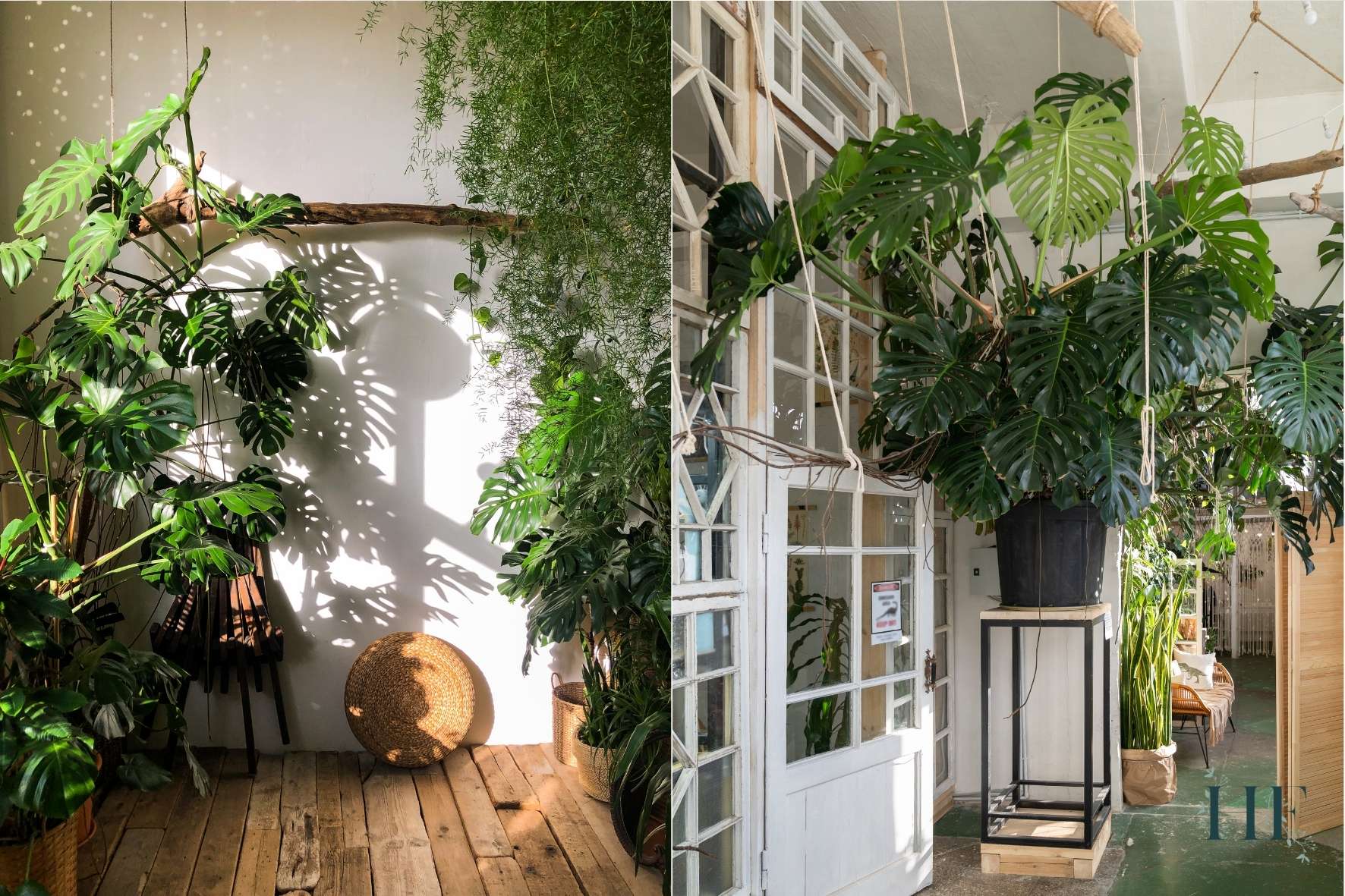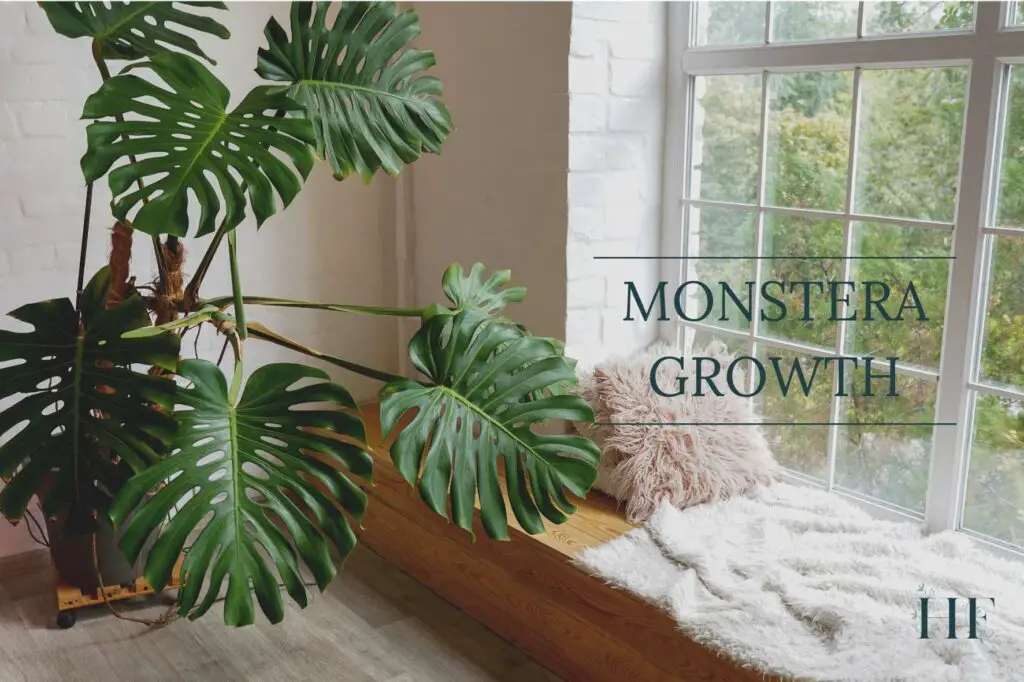Monstera plants grow quite big both indoors and outdoors. These climbing perennials grow natively in the Central and South American rainforests and are known for their massive and unusual leaves and long aerial roots.
But how fast do Monsteras grow indoors? Do all Monstera varieties have the same growth rate or reach the same height and width? And how can you get your Monstera to grow faster?
In this blog post, I will answer those questions and share other facts about their growth stages and life cycle.
Monstera Growth
The Monstera genus belongs to the Araceae (Arum) plant family. All 49 Monstera varieties are native to the tropical regions of the Americas.
| MONSTERA GROWTH FACTS | |
|---|---|
| Family | Araceae |
| Genus | Monstera |
| Biological life cycle | Perennial |
| Foliage | Evergreen |
| Mature size | Up to 66 feet (20m) tall outdoors, and 6 to 10 feet (1.8 to 3m) tall indoors. |
| Time to maturity | 2 to 3 years. |
| Lifespan | More than 40 years. |
In the wild, Monsteras reach towering heights thanks to their aerial roots. They are generally large, and a mature Monstera can grow to heights of 66 feet (20m) tall when climbing by a tall enough tree.
Despite their size, they are recognized for their attractive but unusual foliage (fenestrated leaves). Most species have large leaves that can grow 9.8 to 35.4 inches (25 to 90 cm) in length and 5.9 to 29.5 inches (15 to 75cm) in width.

Monstera Growth Stages
Monstera has three growth stages: seedling or baby Monstera, juvenile or young Monstera, and adult or mature Monstera.
Seedling or Baby Monstera
A Monstera is considered a seedling when newly germinated seedlings still depend on the seed for at least some resources. At this stage, they grow as terrestrial creepers.
Young or Juvenile Monstera
A young or juvenile Monstera is the middle stage between being a seedling and the plant reaching maturity.
At this stage, Monstera grows both as a terrestrial creeper or climber. Their leaves look different to their mature stage too.
As a Monstera plant approaches maturity, leaves may fenestrate, split, or both.
Adult or Mature Monstera
An adult or mature Monstera starts producing mature leaves and flowering (in the natural tropical habitat). Depending on the species, it can take anything from 1½ to 8 years.
On average, it takes 2 to 3 years for a Monstera plant to reach maturity and start putting out fenestrated leaves.
As young Monsteras start climbing and mature, they lose the link to the ground (the connected stem may rot or break). This is the part of their life cycle that they live as epiphytes.
Monsteras are hemiepiphyte since their roots go both downwards into the soil and upwards climbing over trees, i.e. they are generally climbing but are also terrestrial. But, when they reach maturity, Monsteras ignore the soil base, losing their connection with the earth.
However, their aerial roots can always decide to link back to the soil creating new roots that go downwards.
Mature Monsteras have large leaves, except for Monstera Karstenianum (also known as Monstera Peru). Also, depending on the Monstera variety, the leaves may fenestrate (getting holes or/and splits), or remain whole.
Here is what to expect from the most known Monstera types:
- Monstera varieties with fenestrated leaves with both holes and splits: Deliciosa, Dubia, Epipremnoides, and Pinnatipartita.
- Monstera varieties with fenestrated leaves with holes only: Adansonii, Acuminata, Siltepecana, Acacoyaguensis, Lechleriana, and Obliqua.
- Monstera varieties with fenestrated leaves with splits only: Subpinnata, Dissecta, and Spruceana.
- Monstera varieties with no fenestration: Karstenianum and Standleyana.
- Monstera varieties with the same juvenile and adult leaves: Karstenianum – its leaves don’t change much. They may increase in size a little bit.
The older the Monstera plant, the more the leaves are covered with its familiar large perforations (apart from Karstenianum and Standleyana varieties). To learn more about this peculiar phenomenon, check the Monstera Leaves and Fenestration Stages [Split Tips Included] blog post.
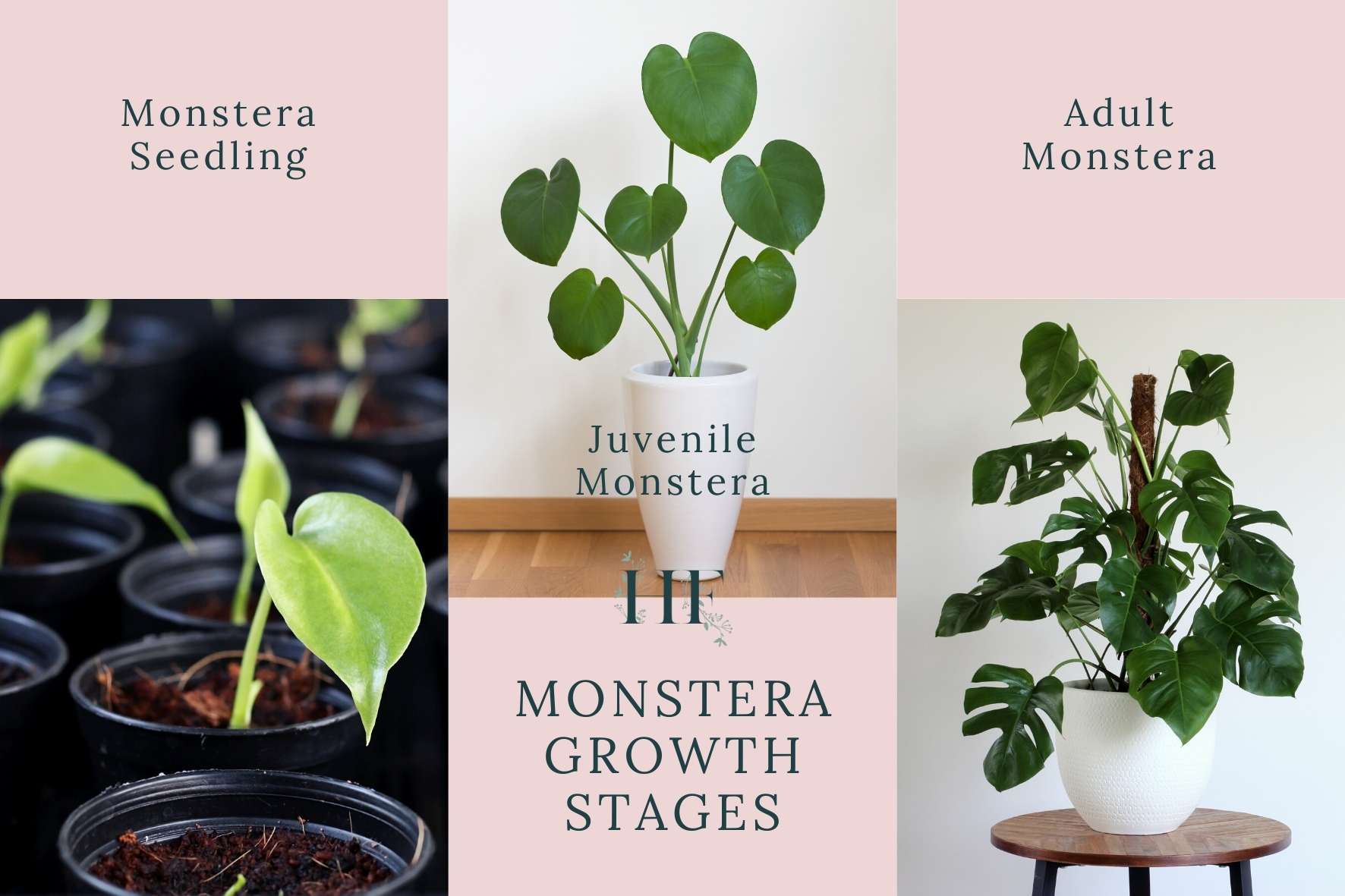
Monstera Growth Rate
The Monstera genus contains 49 species of plants, and each grows at its own rate. The two most popular varieties, Monstera Deliciosa (Swiss Cheese Plant) and Monstera Adansonii (Swiss Cheese Vine), on average grow 1 to 2 feet (30.5 to 61cm) per year with proper care.
One thing that is important to note is how Monsteras grow. Most varieties will tend to grow horizontally rather than vertically, with their huge leaves spreading wide.
In general, Monsteras will put out a new leaf every 4 to 6 weeks. As the plant ages and grows bigger, it can produce even more leaves per month.
However, Monsteras don’t have multiple growth points. Monsteras only grow one leaf per node. Rhaphidophora Tetrasperma (known as Mini Monstera), which is often confused as a Monstera variety, can have multiple leaves per node.
The leaves are not the only thing that grows to enormous proportions, so do their aerial roots. Over time, they can reach several feet in length.
You can increase your Monsteras grow rate by providing it with ideal growing conditions. Staking and supporting Monstera plants can also encourage vertical growth rather than horizontal spreading. Continue reading to find out tips on how to grow Monsteras faster.
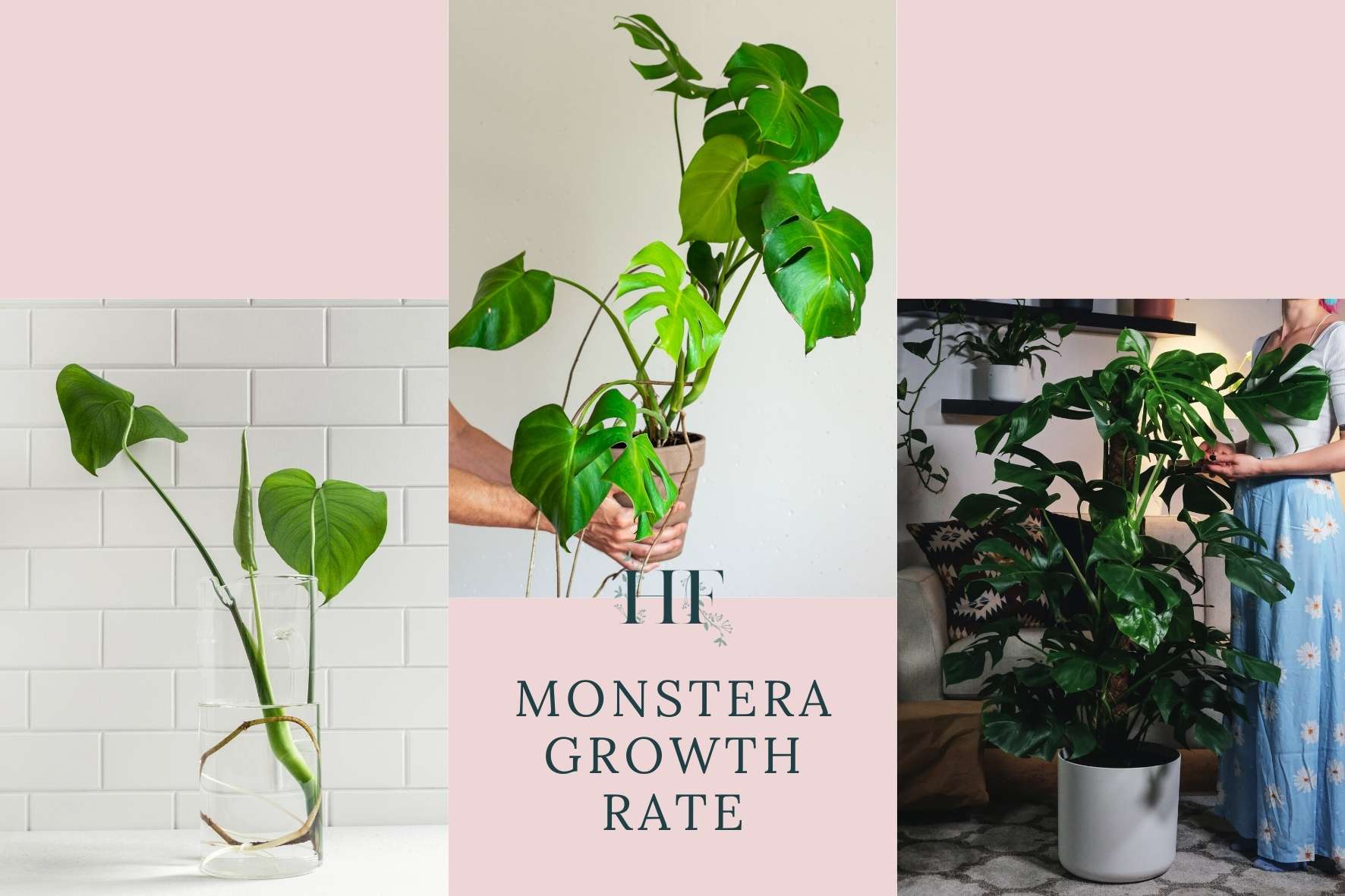
How big will my Monstera grow?
Monsteras growth rate depends on the species variety. Take a look at the table below to get an idea on what to expect:
| MONSTERA VARIETY | MONSTERA GROWTH RATE* | MONSTERA HEIGHT INDOORS | MONSTERA HEIGHT OUTDOORS |
|---|---|---|---|
| Monstera Deliciosa | 1 to 2 feet | 6 to 10 feet (1.8 to 3m) | Up to 66 feet (20m) |
| Monstera Adansonii | 1 to 2 feet | 3 to 5 feet (0.9 to 1.5m) | Up to 13 feet (4m) |
| Monstera Dubia | 4 to 10 inches | 3 to 6 feet (0.9 to 1.8m) | Up to 10 feet (3m) |
| Monstera Epipremnoides (Esqueleto) | 4 to 10 inches | (smaller than outdoors) | 7 to 13 feet (2.1 to 4m) |
| Monstera Obliqua | 1 to 3 leaves | (smaller than outdoors) | 6 to 10 feet (1.8 to 3m) |
| Monstera Punctulata | 1 to 2 feet | 7 to 10 feet (2.1 to 3m) | Up to 50 feet (15.2m) |
| Monstera Karstenianum (Peru) | 8 to 36 inches | (smaller than outdoors) | 6 to 8 feet (1.8 to 2.4m) |
| Monstera Standleyana | 1 to 2 feet | 2 to 5 feet (0.6 to 1.5m) | Up to 20 feet (6.1m) |
| Monstera Pinnatipartita | 4 to 10 inches | 4 to 6 feet (1.2 to 1.8m) | Up to 66 feet (20m) |
| Monstera Siltepecana | 2 to 3 feet | (smaller than outdoors) | 6 to 8 feet (1.8 to 2.4m) |
| Monstera Variegata | 1 to 2 feet | Depends on the cultivars’ species. | (no data) |
| Rhaphidophora Tetrasperma (Mini Monstera)** | 6 to 12 feet | 6 to 8 feet (1.8 to 2.4m) | 15 to 20 feet (4.6 to 6.1m) |
Variegated Monstera Growth Rate
Variegated Monsteras grow more slowly than non-variegated ones. Also, these cultivars rarely achieve their species’ average size indoors.
This means that a Monstera Deliciosa Variegata might not achieve 6 to 10 feet (1.8 to 3m) height indoors as a Monstera Deliciosa would.
The reason for a slower growth rate among variegated Monsteras is that they don’t have as much chlorophyll with which to photosynthesize. So, they have less energy to grow.
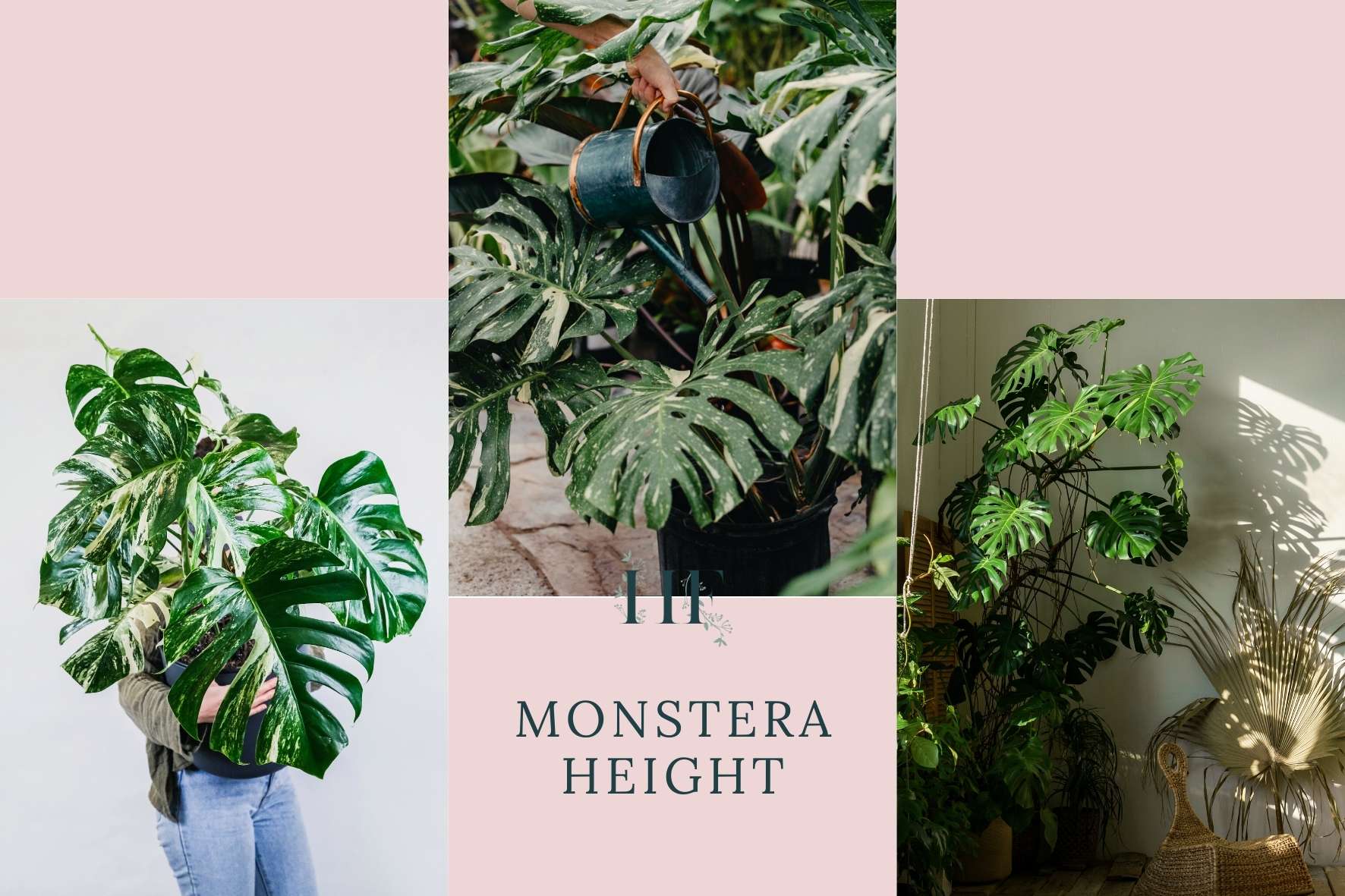
Monstera Growth Through the Seasons
Monstera plants’ growth season is from early spring to the end of summer in the northern hemisphere. This is the period when they are actively growing and will grow at their fastest rate.
Monsteras go dormant during autumn and winter, which means that their growth rate slows down or completely stops until spring comes. This is due to a drop in temperature, the length of the day getting shorter, and plants receiving less natural light.
In the northern hemisphere, it is less likely to spot a new leaf unfurling in winter. But, it highly depends on where you live and the climate in your area.
However, you can expect new growth if the environmental conditions don’t change much compared to summertime i.e. when your Monstera is still getting plenty of light and humidity, and there’s hardly any temperature change.
If you live in a tropical or sub-tropical climate, your Monstera might grow new leaves every couple of weeks.
That being said… If you want your Monstera to continue growing during the winter months, you can try moving it to a sunnier spot in your house. You could also try using full-spectrum grow lights to supplement your Monstera’s light needs and encourage new growth.
Monstera Growth FAQ
Because you might have a few more questions about growth (I sure did), here are some frequently asked ones:
Are Monsteras Easy to Grow?
Although some rare species are more challenging to care for than others, most Monstera plants are generally considered low-maintenance, easy to grow, and suitable for beginners.
As houseplants, both Monstera Deliciosa and Monstera Adansonii varieties are easy to grow and maintain. So, if the Monstera genus is new to you, either variety is a good choice to begin with. I went for Deliciosa because I love its heart-shaped fenestrated leaves.
See Monstera Deliciosa on Etsy and Monstera Adansonii.
Insider Tip: When buying a Monstera, you can buy a small plant because they are known to grow fast and the smaller and younger the plant, the easier it will adapt to your environment. So, there’s no need to spend a huge amount on an big Monstera plant.
How Long Does It Take a Monstera to Reach Full Size?
On average, most Monstera plants can reach maturity within 2 to 3 years. That being said, Monsteras will continue to grow in size, both vertically and horizontally.
But, when they reach maturity, their leaves will start to fenestrate.
Are Monstera Plants Slow-Growing?
A Monstera plant’s growth rate will depend on the variety or species, and the growing conditions (i.e., proper care). On average, Monsteras can grow 1 to 2 feet (30.5 to 61cm) per year. This is the case for Monstera Deliciosa and Monstera Adansonii.
Other varieties have a slower growth rate, like Monstera Dubia, Monstera Epipremnoides and Monstera Pinnatipartita.
How Big Can a Monstera Grow?
Depending on the species, Monsteras can grow very big in their natural habitat.
Both Monstera Deliciosa and Monstera Pinnatipartita can reach up to 66 feet (20m) in height in the wild. This makes them the biggest plants among the Monstera genus.
The closest to that size is Monstera Punctulata, reaching 50 feet (15.2m) outdoors.
Obviously, an indoor Monstera will never be as large as a wild one, but that doesn’t mean that they cannot grow to be massive. When growing Monstera indoors, on average, they can get between 6 to 10 feet (1.8 to 3m) tall.
How Often Do Monsteras Grow New Leaves?
Most varieties will put out a new leaf every 4 to 6 weeks during the growing season (the spring and summer months).
Although a young Monstera plant grows new leaves every 4 to 6 weeks, as the plant ages, the rate of growth will begin to increase too. This is because more nodes exist, (i.e., more growth points), therefore more new leaves can be produced.
These nodes contain the cells necessary for a new leaf to grow, as well as for new stems to grow. As these stems grow, more and more nodes are created, and therefore leaves are grown with greater frequency. However, expect one leaf per node.
How fast Monsteras grow new leaves will also depend on their growing conditions. To encourage leaf growth (and fenestration), check the Monstera Leaves and Fenestration Stages [Split Tips Included] blog post.
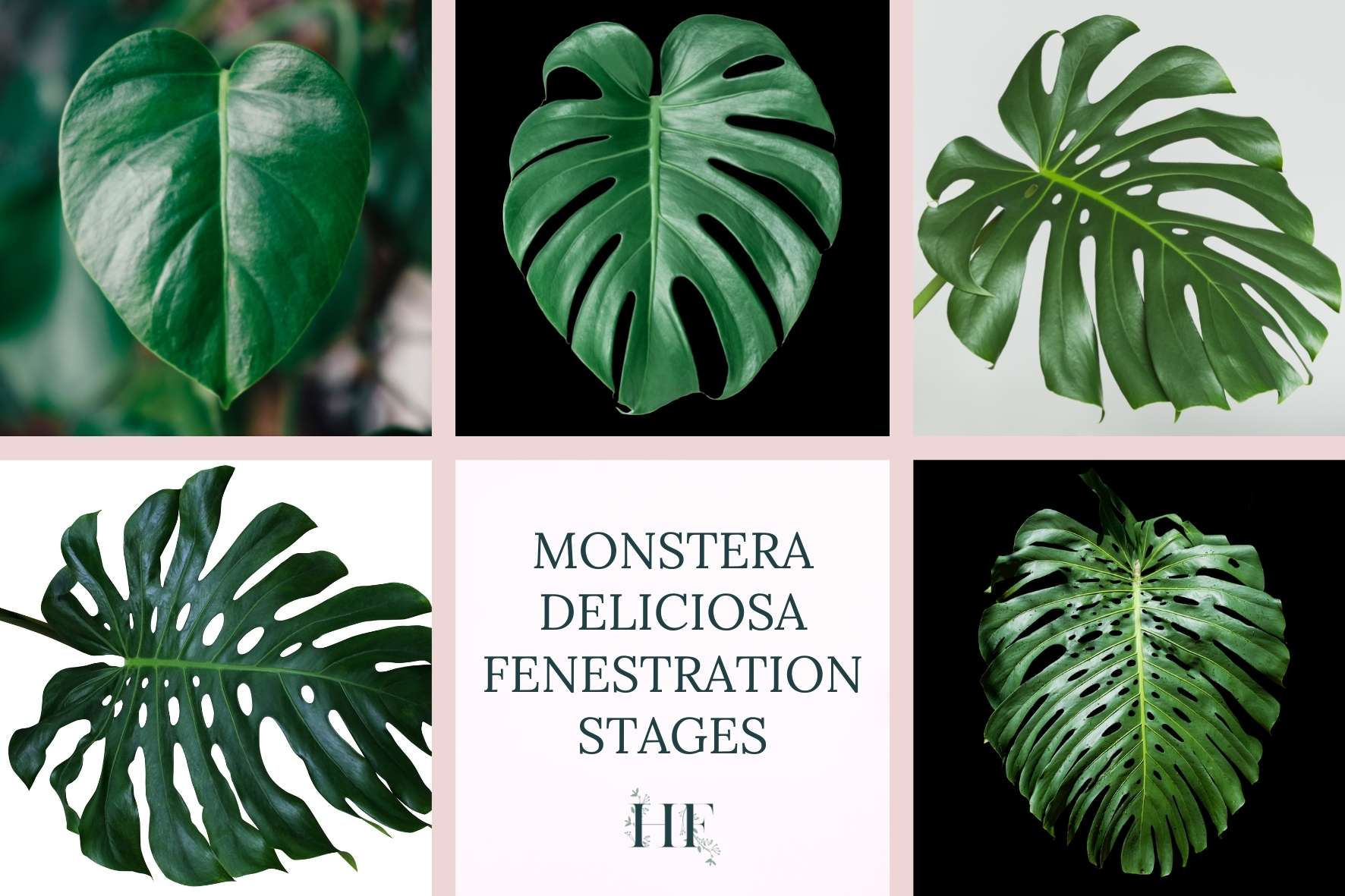
How Long Does It Take for Monstera Leaves to Split?
Monstera leaves will typically split between 2 and 3 years of age, once they reach maturity. Factors like the amount of sunlight, water, humidity, and fertilization need to be taken into account to ensure a Monstera develops leaf fenestration.
The exceptions are Monstera Karstenianum and Monstera Standleyana since they don’t develop fenestration (neither holes nor splits) once they reach maturity.
How Long Does It Take for Monstera to Grow Aerial Roots?
Monstera aerial roots tend to grow out of the plant’s nodes. They begin as small brown knobs that grow from the Monstera’s stem and, over time, can reach several feet in length.
As a guideline, a Monstera grows aerial roots once it has reached around 10 inches (cm) in height and it has grown 3 to 4 leaves from the same stem or vine.
Monstera aerial roots can grow quite thick in the wild, but at home and indoors, they tend to stay thin (around 1 centimetre or 0.4 inches in thickness). However, they can grow pretty long and stick out in all directions as your plant looks for support.
You can find more about them, including what to do with them (a commonly asked question) at Monstera Aerial Roots – 11 Frequent Asked Questions Answered blog post.
How Do I Tell How Old My Monstera Is?
The age of your Monstera plant is determined by the size and fenestration stage of its leaves.
A baby Monstera or seedling has small solid heart-shaped leaves (i.e., no fenestrations).
Young or juvenile Monsteras (1 to 3 years old) still have small heart-shaped leaves but some of their leaves will start to show side splits (fenestration stage 2).
Adult or mature Monstera plants will have very large leaves that may even start to create a second or third set of fenestrations. These are stages 3 and 4 of fenestration, stage 5 being the final one.
The entire fenestration process takes between 4 to 6 years.
Another great way to gauge the age of your Monstera plant is by its height. A healthy Monstera will grow between 1 to 2 feet each year. You can simply measure it to determine its age for the first 6 years.
Does Cutting Monstera Promote Growth?
Pruning your Monstera encourages growth, plus it helps to keep your plant healthy. You can prune in a particular part of the plant to encourage new growth and create a more compact plant.
When pruning a Monstera to promote new growth, determine where you would like new growth to appear, select a stem, locate the node and make a clean cut just above the node. New foliage will sprout along the vine.
Check A Guide to Monstera Pruning (How, When and Why) to develop an adequate pruning practice and keep your Monstera growing healthy and happy.
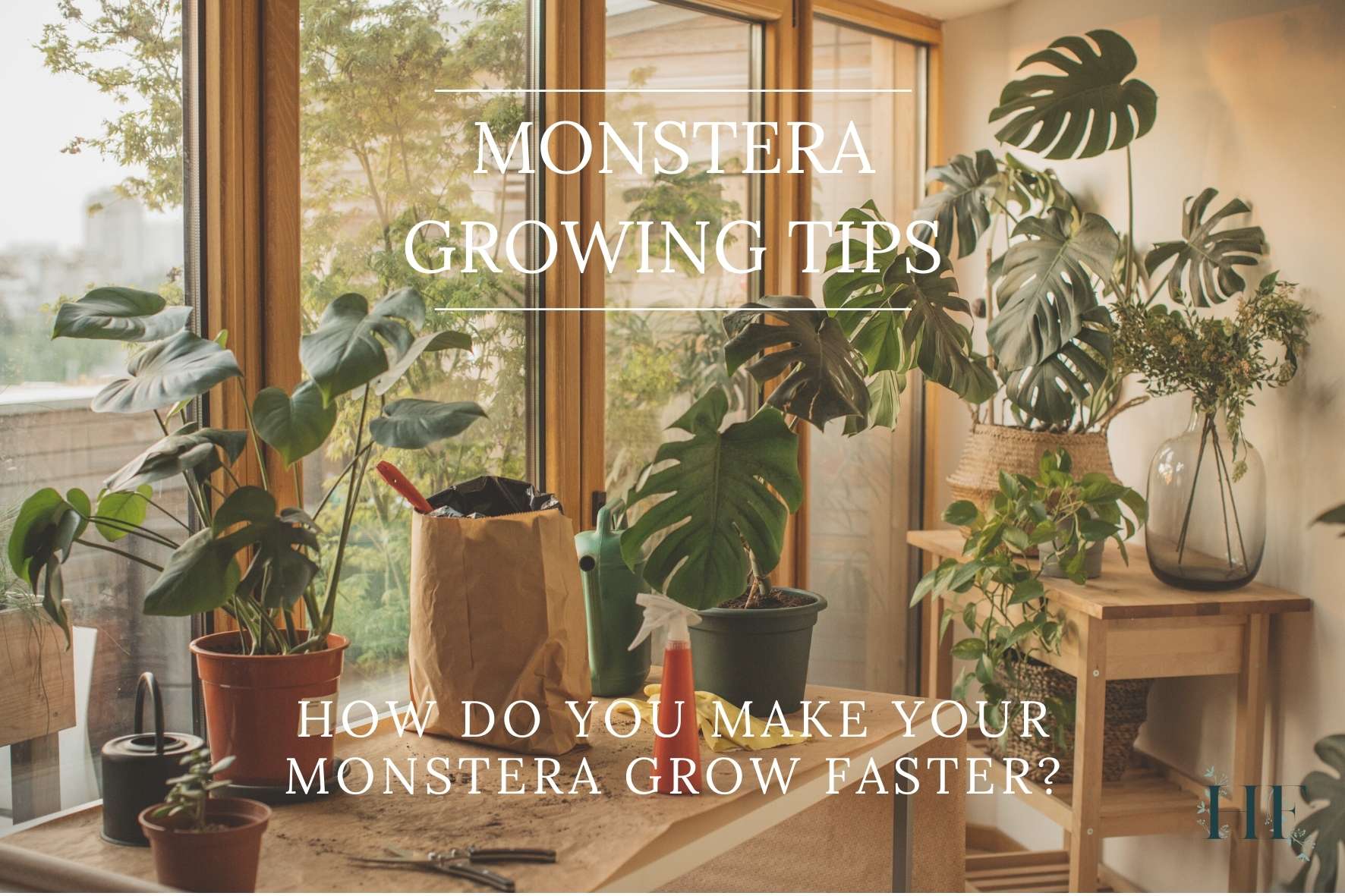
Monstera Growing Tips
There are a number of factors and practices that will encourage growth in your Monstera: time of year, sunlight, watering, temperature, humidity, fertilizing, pot size, soil condition and stacking.
Here are some tips to grow Monstera plants bigger and faster:
1) Increase Its Light Amount and Quality
Increasing the amount of light your Monstera gets a day is the biggest thing you can do to make your plant grow faster (and for it to look bushier too).
Monsteras need bright, indirect sunlight for a minimum of six hours a day. Too much sunlight can result in sunburn, resulting in brown and dry leaves. Too little light can slow growth significantly, resulting in yellowing leaves with few-to-no fenestrations.
To maximize sunlight hours and avoid too strong sunlight, a spot that receives bright indirect light 2 to 4 feet (0.6 to 1.2 m) removed from a southern or eastern facing window is ideal to grow a Monstera.
For example, I live in the U.K. and I have mine a meter from a big east-facing window that has a sheer curtain (which prevents the sun from burning the Monstera leaves during the summer).
To increase the light amount, you could:
- Place it near an east-facing or south-facing window.
- Take it outside during the warm weather. But avoid direct sunlight and be aware that this can result in pest infections.
- Use grow lights to supplement the amount of light it gets. I recommend this grow light because it’s full-spectrum and affordable.
Read also: Monstera Light Requirements – How Much Does It Need?
2) Raise the Humidity Levels
The second most important thing that will dramatically increase how fast your Monstera will grow is increasing its humidity levels.
As houseplants, Monsteras thrive in humid environments, especially those with a humidity level between 40% to 60%. This range is also applicable for variegated Monsteras.
The 40% to 60% range is what most houses have in Europe and the US. So, maintaining this level of humidity somewhere in between is sufficient for your Monstera to thrive.
If you are not sure about the humidity levels of your home, you can get a hygrometer. I use ThermoPro hygrometer, which measures both humidity and temperature.
However, if you increase your Monstera’s humidity levels to 60% or even up to 70% (or 80%) for some Monstera varieties, you will encourage more rapid growth.
For humidity preferences according to Monstera species, you can check The Ultimate Guide to Monstera Varieties (22 Types) blog post, where I share care tips according to the type of Monstera.
The downside of this tip is that it might require a humidifier, which is the most effective way to increase humidity levels. It will benefit your Monstera and other houseplants that benefit from medium to high moisture in the air.
The one I recommend is the Levoit humidifier, which provides both warm mist (closely replicates humidity in the wild) and cool mist types. Plus, it’s programmable, so it’s hands off!
Finally, Monstera plants prefer warm temperatures. The ideal temperature range for an indoor Monstera is between 20 to 30°C (68–86 °F). Staying within that range will keep your Monstera happy and help it grow healthy.
Read also: Monstera Humidity & Temperature Needs – 7 Tips to Get It Right.
3) Maintain a Consistent Watering Routine
Giving your Monstera water every time it needs it reduces the plant’s stress and improves its growth rate. This is a great tip because you can control how often you water your plant with little additional financial cost.
When Monsteras don’t have enough water, they go into survival mode, so all of the plant’s energy will focus solely on staying alive. Conversely, when you overwater it you can cause root rot, which can result in your Monstera dying.
Monstera plants have a moderate water requirement, which means you should water when the soil feels moist one or two inches below the surface.
As a general rule, you can water your Monstera when the topsoil has dried about 80% of the way, which means that the soil feels moist 1 to 2 inches below the surface. Usually, this happens once a week or once every two weeks.
However, it’s key to check if your Monstera needs water before watering it, this avoids both overwatering and underwatering problems.
Until you are able to spot a pattern on your Monstera’s watering needs, which will also vary depending on the season, you will have to check the soil fairly often.
You can monitor or measure the moisture in the soil using a moisture meter, which removes any doubts you may have when sticking your finger to gauge if the soil is wet or not.
Read also: A Guide to Monstera Water Needs (How Often and When).

4) Fertilise Consistently During the Growth Season
Monsteras need fertiliser to replenish the nutrients in the soil mix, which allows them to grow bigger and healthier, putting out new leaves, including fenestrated ones.
You can fertilise your Monstera once a month or every two weeks during its growing season (the spring and summer months, from April to September, in the northern hemisphere). This recommendation is based on an organic liquid fertiliser with a 3-1-2 N-P-K ratio.
You can continue to fertilise your Monstera during the dormant season (autumn and winter) if you are using grow lights to encourage new growth.
When looking for fertiliser, I recommend going for an organic liquid fertiliser like LiquiDirt since you can use it for watering and also for propagation!
To avoid fertiliser burn, dilute 20ml or 2 teaspoons into a gallon of water (1 gallon is 4.5 litres or 8 pints, which is usually the capacity of a regular watering can).
Read also: A Guide to Monstera Nutrients (Why, When and How to Fertilise), which includes other types of fertilisers, both organic and synthetic, and how to use them.
5) Repot Your Monstera Every Two Years
When Monsteras become rootbound, they will stop growing.
So, check if your Monstera needs repotting. Roots protruding from the drainage holes are a sign that a plant needs repotting.
You will want to repot your Monstera once every 2 to 3 years. This will allow your plant to continue growing since the roots will have enough space.
When repotting, choose a container about 2 inches larger than the current pot. I recommend clear plastic pots with drainage holes, which I then put inside a decorative cachepot. Clear pots allow you to keep an eye on the root system and avoid root rot thanks to their drainage holes.
Insider Tip: Avoid a pot that is too big. Larger pots hold a lot of soil, which in turn retains a lot of moisture, which increases the chances of overwatering and root rot.
Also, the type of soil you use is important. Since Monsteras are an aroid plant, they need light, airy and breathable soil. Monstera plants do best in a light, chunky soil mix with a pH of 5.5 to 7 (i.e., slightly acidic).
The best way to achieve that type of medium is to use a mixture of indoor potting soil, a handful of orchid bark chips, loose coco coir, perlite or even some organic matter like worm castings.
Alternatively, you can also add an already-to-go mix of coco coir and perlite into the houseplant compost. There’s also a Monstera-specific potting soil available on Amazon.
Read also: A Guide to Repotting Monstera (When, Why and How).
6) Staking (Supporting) Your Monstera
Staking, i.e., supporting your Monstera with a stake, will also encourage growth.
Monsteras are climbing plants and they grow like vines, which means they need a stake or support to help them reach their impressive heights.
With nothing for their aerial roots to grab onto, your Monstera won’t grow at its ideal rate. Also, not providing your Monstera with support can possibly hinder its overall growth and result in heavier stems snapping over time.
Monsteras can grow even faster if staked up, rather than propagated. So, if you allow your Monstera to climb, it will grow bigger leaves.
You can support your Monstera by guiding them into a trellis or moss pole. You can secure the most mature stem or vine against a moss pole or trellis using a twist tie.
I use and recommend a twist tie to attach your Monstera to the support system because it’s a soft tie that doesn’t damage the vines.
If using a moss pole, you will need to periodically mist the pole to keep it moist. This will make it easier for the aerial roots to grow into the pole. Keeping it moist enough can be a challenge for some, however.
High humidity is the key to success here. If you have low humidity, you may struggle to get the aerial roots to attach to the pole.
Insider Tip: Regardless of the type of support you choose, make sure its higher than your Monstera, so your plant has some space to grow into.
Read also: A Guide to Monstera Training – How to Make Them Climb.

7) Keep Your Monstera’s Leaves Dust Free
Keeping your Monstera dust-free is still a way of convincing your plant to put out more leaves. And it doesn’t cost you! Finally, a free tip 😉
Clean your Monstera’s leaves every 2 weeks to prevent dust from accumulating. This will help your Monstera absorb sunlight and moisture without a problem, both actions vital for encouraging growth.
Dust inhibits the plant’s ability to photosynthesize. Essentially, it clogs their pores, preventing them from “breathing.”
You can use a wet soft cloth (I use a microfibre cloth) to remove the dust. Remember that all parts of a Monstera are toxic, causing skin irritation, so you might want to use a pair of gloves when cleaning its leaves.
Insider Tip: If your tap water is hard, use rainwater or spring water to wet your cloth. Filtered water works too. Hard water will leave white marks on the leaves that, apart from looking ugly, will clog your plant’s cells.
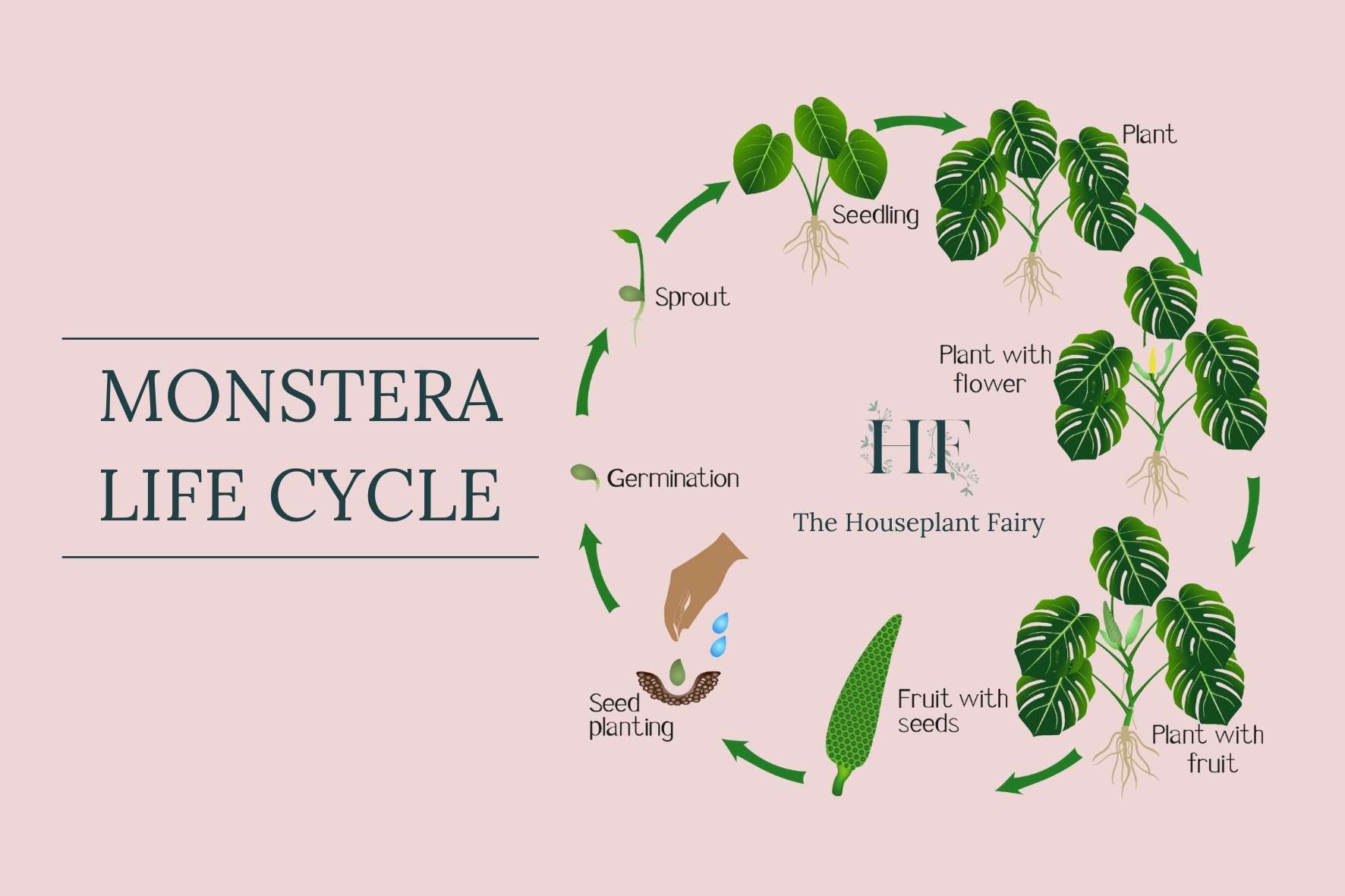
Monstera Life Cycle
Monstera plants are perennial plants with an annual blooming cycle. However, not all Monstera varieties produce flowers and fruit.
There are 7 stages of a Monstera plant life cycle:
- Germination (Monstera seed planting).
- Sprout (Leafy growth).
- Seedling (Juvenile Monstera).
- Growth (Mature Monstera).
- Flowering and pollination (Monstera with flower).
- Fruit and seed formation (Monstera with fruit).
- Ripe fruit (harvest time) and seed spread.
Monstera Seeds
Monstera fruit contains seeds, which are found within the fruit pulp.
Wild seedlings grow towards the darkest area they can grow until they find a tree trunk, then start to grow up towards the light, creeping up the tree.
To harvest Monstera seeds, you need to wait until the fruit is ripe. Then, you break apart the hexagonal berries inside the fruit. Generally, the seeds are either white in colour or pale green.
Although you can germinate Monstera seeds at home, growing a Monstera from seeds is a long process and it will take months before you see the first leaf appearing – even in ideal conditions!
Seeds will germinate and sprout within weeks but they are extremely slow to develop. It can take from 10 days up to 3 weeks depending on the conditions.
Monstera Flower
Monstera flowers have no specific blooming time or season in the wild. In its tropical and subtropical habitat, the plant flowers easily. In ideal conditions, Monsteras flowers about three years after planting.
However, a Monstera flowering indoors is rare, they rarely bloom in cultivation. Specific conditions need to be met for the plant to flower indoors. Although a Monstera is unlikely to flower as a houseplant, it can bloom somewhere that mimics its natural habit very well, like a greenhouse.
The Monstera flower is a fleshy erect spadix or spike with tiny blooms surrounded by a boat-shaped spathe. This spathe can be white or yellow and have a white to green flowering spadix, depending on the type of Monstera. The flowers mature upward starting from the base.
The Swiss Cheese Plant flowers in its natural habitat. Monstera Deliciosa flowers are creamy-white and large, about 8 to 12 inches (20 to 38.4 cm) in length.
Most Monstera species will produce a cluster of 2 to 4 spadices. But Monstera Obliqua may have up to 8 spadices clusters, and Monstera Lechleriana will have only one. To know more about specific varieties and their flowers, check The Ultimate Guide to Monstera Varieties (22 Types) blog post.
Monstera flowers get pollinated by beetles, bees, and some flies, and to prevent cross-pollination, the female flower part matures early by a day or two. However, the flowers can self-pollinate too since they contain both androecium and gynoecium.
The Monstera flower is not edible; all the parts of the plant are toxic.
Monstera Fruit
Monstera Deliciosa is also cultivated for its edible fruit which tastes like a combination of banana and pineapple. The fruits are considered a delicacy in local markets due to their rarity.
In warm, wet, and humid growing conditions, the Monstera Deliciosa plants will also flower and produce cylindrical, oblong fruits.
Monstera Deliciosa fruits ripen slowly, taking anywhere from 10 to 14 months to mature. They can grow up to 25 cm in length and average 3 to 5 cm in diameter.
The exterior is covered in a protective layer of hexagon-shaped green scales that are inedible. The scales transition from dark to light green, sometimes pale yellow, and as the fruit matures, the scales flake off, revealing ivory to cream-coloured flesh.
It takes longer than a year for fruits to reach maturity.
The flesh is divided into small kernel-like capsules that can be shaved or hand-pulled off a central, hard, and inedible core (like you would with corn from the cob). The fruit must be ripe before consumption. They are a source of potassium and vitamin C.

Monstera Lifespan
A Monstera’s lifespan is more than 40 years, which is why they are considered heirloom plants. However, a Monstera’s life expectancy will depend on the plant growing under suitable conditions and receiving the proper care.
Given the proper growing conditions, Monstera plants living indoors and outdoors can both achieve similarly impressive lifespans. That being said, it is generally easier to provide ideal conditions for an indoor plant than an outdoor one. Houseplants are less likely to experience extreme weather conditions or pests.
These plants have adapted to strenuous jungle conditions and are very strong and resilient, which may contribute to their lifespans.
But, at some point, the plant will start to yellow and the leaves will drop off. Eventually, the stem will also turn brown and die.
Although it’s sad to see your plant die, the positive side is that you can always propagate your Monstera to create new plants. This is a great way to expand your collection and keep the plant alive in your home for generations.
